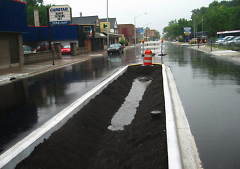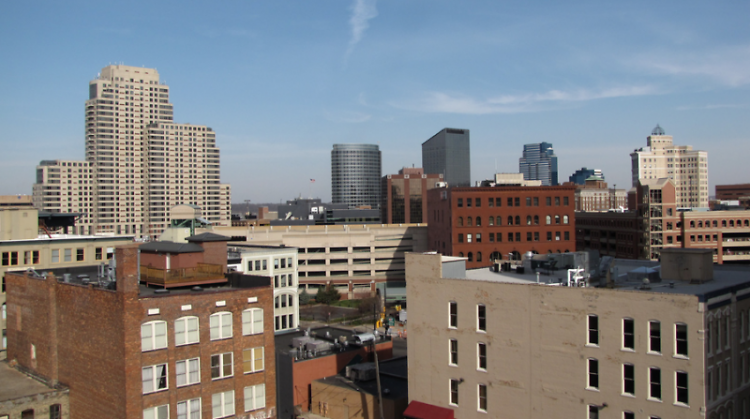
Construction of bioswales on Plainfield Avenue /Julie Tabberer

Grand Rapids skyline /John Eisenschenk

Construction of bioswales on Plainfield Avenue /Julie Tabberer
Written by Kristopher Larson, AICP
The struggle between the values that shape cities can leave indelible marks on the urban landscape. Two of those values which often find themselves in conflict are utility and health, and the design implications for the two have created distinguishing effects to the built character of cities. An obvious example includes the suburbanization of our cities for the sake of accommodating vehicular access, speed and storage that rendered the scale of cities to one that is wholly unhuman. Built at the scale of the car, our cities discourage healthier mobility decisions, produce profound environmental degradation and forsake opportunities to relate to the same emotions and interests that bind people socially, including: beauty, approachability, diversity, authenticity, spontaneity and whimsy.
Over time, responses to an overemphasis on utility has sparked important transformational opportunities for our cities. The advent of zoning to address some of the physical character of our cities emerged from complications related to the lack of quality of living conditions in New York City at the turn of the century. Property owners had no responsibility to provide access to light, alternate means of egress for emergency situations, or even running water or restrooms. Such unsanitary conditions and squalor contributed to the spreading of disease, a vulnerability to catastrophic fires and the general degradation to the quality of life. The resulting regulatory solutions, such as architectural step backs and requiring windows, created the basis for some of the building design standards that have become generally universal in American cities, and are a foundation of the role of Planners to protect the health, safety and welfare of citizens.
Current code requirements such as a window per bedroom not only provide people with a means to exit the building in the case of an emergency, but it also provides us access to the sun- which in turn gives us the physical benefits of light and warmth, and also the biological benefits of melatonin regulation, vitamin D production and of course, the production of oxygen by our friends in the plant kingdom. These are all paramount needs of people- and the inclusion of a window per bedroom now seems incredibly obvious. Yet a century ago, it wasn’t. The simple function of residential tenement housing, and perhaps its profitability, was the primary focus. Health wasn’t.
In present time, we’ve managed to engineer design and technology solutions for most of the travails of the human condition. Fire suppression devices help prevent fires from engulfing entire buildings. Open space requirements provide people with pastoral refuge, and accessibility improvements aspire to provide equality to all people, regardless of ability, via manageable urban terrain and access. Collectively, we’ve made big strides on important design issues that have enabled cities to do more to encourage better public health.
The next frontier for the conflict between utility and health is certainly one of mobility. Study after study has shown how the physical form and land use patterns of our cities have exasperated obesity. Again, the values of vehicular access, speed and storage cause us to make decisions about our cities that compromise our health interests as humans, and we’ve been forced to tolerate exaggerated roadway widths, accept inappropriate land uses, and asked pedestrians to take their lives in their own hands in negotiating curb cuts and intersections lest they impede the travel of motoring public. We’ve traded our waistlines and pedestrian well-being for utility.
Mobility, however, isn’t the today’s version of the tenement housing issue. On one hand, rarely was there any upside for the residents living in the squalor of yesteryear- and I’m guessing that few, if any, would opt for unsanitary living conditions if given the choice. Secondly, tenement housing was the result of a lack of regulation. America’s automobile dependence is largely the result of public policy and regulation. Massive public incentives helped create and maintain the public roadway network, whereas it is market preferences that are enabling the evolution of alternative modes and land use patterns. There will likely be cars for the foreseeable future, and the efforts to improve mobility are not focused on a one-size-fits-all style of travel. It’s about creating choice- such that people can enjoy viable options- each with their respective costs and benefits. Those who choose to walk to work can do so for the economic and health benefits, and those who choose to drive can do so according to the values and benefits they prioritize. A reliance on car travel as a single mobility option does not improve public health. In fact, it deteriorates our cities’ and citizens’ shared health.
Mobility aside, there are profound relationships between the shapes of our cities and the health of our citizens. Cities are, after all, the physical construct that unites people in commerce, celebration, spirit and neighborhood. Just as our bodies require our circulatory, nervous, respiratory and musculoskeletal systems to perform efficiently and effectively, our cities have their own systems that require care and feeding. And just like people, health is about the stuff on the outside too. As the Knight Foundation’s Soul of the City study found, aesthetics is one of the most important variables in fostering a relationship between a city and its people. The health of a city and its citizens is both symbiotic and intertwined, but it is up to the citizens to serve as the stewards of a city’s body and soul.
As we heal our cities, they heal us. While important, the health of the city shouldn’t be solely a focus on the big stuff. Innumerable opportunities exist to contribute to your city’s health. Help support better circulation by making use of the available transit options. Expand your city’s brain power by volunteering at a local school or university. Exercise your city’s muscles by supporting local business, or making an investment in an upstart business. Accentuate your city’s positives via a contribution to a local public art project. Because when you care for your city, you help it care for us. Walking to work will burn off that extra slice of holiday pie, becoming a leader at your neighborhood school will help to improve our school district, supporting local business will grow our local economy and beautifying our city will expand its ability to capture our collective hearts and imaginations.
The Rapidian, a program of the 501(c)3 nonprofit Community Media Center, relies on the community’s support to help cover the cost of training reporters and publishing content.
We need your help.
If each of our readers and content creators who values this community platform help support its creation and maintenance, The Rapidian can continue to educate and facilitate a conversation around issues for years to come.
Please support The Rapidian and make a contribution today.